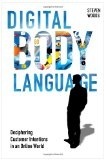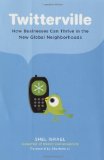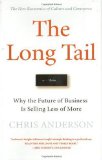Are You Experienced? Three Samples of Virtual Event Experiences
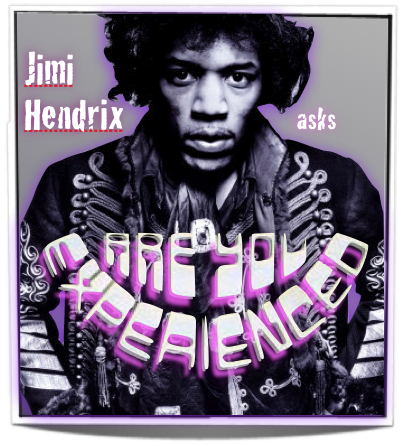 While attending the Virtual Edge Summit 2011 last week, one question asked by attendees is “how do I create an engaging experience.” I would argue that the experience relies not on the platform you select but rather how involved you are in planning, designing, building and implementing the environment. However, many are new to going virtual and are unsure of how to proceed.
While attending the Virtual Edge Summit 2011 last week, one question asked by attendees is “how do I create an engaging experience.” I would argue that the experience relies not on the platform you select but rather how involved you are in planning, designing, building and implementing the environment. However, many are new to going virtual and are unsure of how to proceed.
As such, I plan to write a series of posts to help meeting/event planners and marketers understand the process for going virtual. Please feel free to forward me your questions.
First, there are many types of “virtual events.” Let me highlight three flavors of virtual events that include multiple locations, such as an exhibit hall and auditorium, chat functionality and presentations.
Virtual Event “Out-of-the-Box”
A couple of the vendors are touting that they can build an event in one day. This is possible as certain features have already been pre-selected for you, such as presentation window and chat. While you can add a logo and some other basic branding, there is not much more to this. What you see is what you get with this virtual event.
Pro: Quick and easy set up with minimal monetary outlay (estimate of $5,000-10,000). Once created, you can reuse over and over again as a central library for your archived content and future events.
Con: You get a standard “virtual” event as defined by the vendor with minimal customization. This may or may not work for your particular audience with regard to providing an “engaging” experience. If you plan to use more than once, there may be additional charges for each new “event/presentation” with in the environment.
“Template-Based” Virtual Events
The next level is adding some customization options in terms of the location look-and-feel (usually selecting from a vendor’s library of themes) and adding/taking away certain features such as group chat, locations (i.e. an exhibitor space) and social media with a click of the mouse.
Pro: You have more control over the look-and-feel and how attendees interact with the environment. Like the “virtual event out-of-the box,” once you’ve created it, you can reuse the set-up for future virtual events you hold.
Con: Increased price tag to about $30-60K depending on the features, limited to stock library of images or providing images that fit a specific criteria, and requires more time and effort to design and implement. Furthermore, if using the same format repeatedly, you have to consider additional charges to light-up the environment, as well as if the look-and-feel will become dated.
Fully Customized Virtual Event
The high-end is working with the vendor to develop a fully customized environment from a branded look-and-feel to adding features beyond chat and social media, such as games and quizzes.
Pro: You are intimately involved in the building of the virtual environment that is customized to your event, brand and audience. This provides you with the best option for engaging your audience. Once built, you can add new features to further customize the experience.
Con: This takes a lot of time (recommend at least 6 months to plan, design, build and implement) and can be six figures or more. If you decide to add onto the environment, the challenge is how to integrate any new functionality seamlessly into the overall experience.
Conclusion
In the end, you need to find the right partner based on your budget, expectations and overall experience requirements. In my next post, I’ll highlight the types of questions you should ask when evaluating a virtual events platform provider.
What other pros and cons are there with the above three virtual event scenarios?
PRMM Interviews from #VES11 with Altus and Social27
Here are two videos that I took while I was at the Virtual Edge Summit 2011. Again, while I provided PR/marketing/social media services to the summit, the below represents my personal opinions and not those of the Virtual Edge Summit.
Virtual Edge Summit 2011 – Mobile Comes to Hybrid and Virtual Events
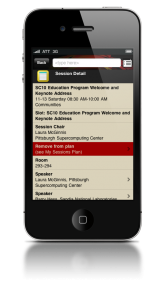
Photo courtesy of Altus
NOTE: I am providing pr/marketing services to the Virtual Edge Summit. This post reflects my personal opinions and is not representative of the Virtual Edge Institute or Virtual Edge Summit.
I previously wrote about some of the efforts we undertook to promote the Virtual Edge Summit. I would like to highlight some of the buzz coming out of the Summit and what this means for marketers. Interestingly, I anticipated hearing some innovations from the key players in the US virtual events market – INXPO (Note: I was previously employed here), 6Connex, and Unisfair.
Rather, for me, I was intrigued by the number of mobile developments by other providers at the show, Altus, Digitell Inc. and Social27. While this was surprising, it fits into my overall predictions about the industry, that newcomers will help push the innovation for virtual and hybrid events. Here’s a quick summary of the announcements. I also had the opportunity to speak briefly with Altus and Social27. Here is a quick overview of the Altus and Social27 news, and I plan to post the videos once I get those completed.
Altus Brings Conferences to the Palm of Your Hand
Altus highlighted their announcement as an extension of physical to provide a “hybrid” experience. The mobile application allows conference organizers to put the conference agenda, sponsor information and even presentations on your mobile device.
Why you should take a look? Since attendees proactively download the app to their device (supports many operating systems), conference organizers can continue pushing updates to attendees long after the conference has ended. If you leverage this as an opportunity to continue a conversation, you can keep members engaged while driving interest for the following conference, as well as open up possible revenue opportunities via sponsorships.
Taking Social Interaction to the Next Level with Social27
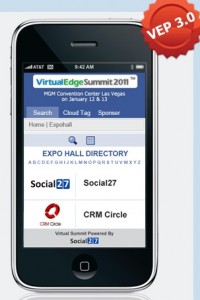
Photo via Social27 Website
Social27 originally started as a service to bring social collaboration to enterprises. Seeing an opportunity, Social27 is moving into events and conferences. The company has a philosophy of “Social, Mobile and Local”, which Ike Singh Kehal, CEO of Social27, explains in his video (coming soon). Like the main U.S. players in the market, Social27 provides an environment with 2D locations for networking, exhibitors and sessions. Since the company comes from the social collaboration space, Social27 provides a simple integration with the key social networks.
Why you should take a look? Social27 does the social collaboration and networking well. I would venture to say that it provides the simplest and most intuitive interface to date. Furthermore, the company leverages the wealth of your social graph to provide “matches” to assist with networking. Currently available on Windows mobile phones, expect Social27 to expand the services to additional mobile OS. By adding the geographic aspect as well, Social27 provides marketers with the ability to search, seek and network with prospects – virtually or in the real world.
Conclusion
The Virtual Edge Summit provided great insight into how marketers can leverage virtual and hybrid events as part of the marketing mix. And an integral part of the experience is extending the event to mobile devices. Do you agree or disagree?
Virtual Edge Institute – An Inside Look at Event PR and Marketing
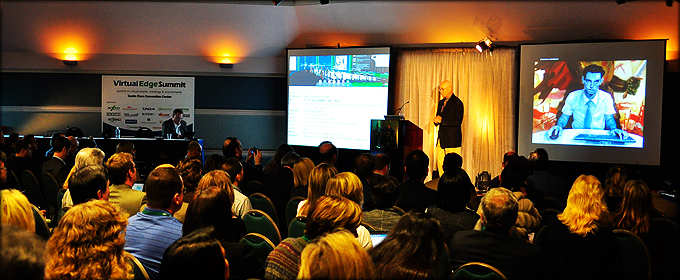
Courtesy of Virtual Edge Summit
From January 12-13, 2011, hundreds of people will gather in Las Vegas and online to attend the Virtual Edge Summit 2011. I have had the pleasure of assisting the Summit in their public relations and marketing efforts. While I have done PR and marketing activities as a vendor exhibiting or speaking at an event, this was an interesting opportunity to help drive awareness, conversation and ultimately registrations for a conference of this sidze (not including corporate webinars and virtual events).
With the conference a week away, we will not have a full sense of the results until after it has concluded. With that said, I wanted to highlight three strategies and tactics we used (are using). While this doesn’t encompass everything we did/are doing for the Summit, it does provide a look under the covers:
Key Objectives
1. Drive Brand Awareness: This year, the Virtual Edge Summit expanded its program beyond virtual events, meetings and conferences to incorporate virtual learning and training. This opened up the Summit a potential new pool of attendees within the elearning and training spaces. Our goal was to continue driving awareness within the meeting and events industry, while introducing the Summit to this new space.
2. Increase Engagement: We wanted to build on the 2010 efforts to further involve our audience – both virtual and physical – with the Summit. This would help generate word of mouth amongst our key audiences and hopefully reach new target audiences.
3. Grow Registrations for In-Person and Virtual Attendance: And of course, part of the success would be measured by the number of registration for the in-person and virtual versions of the event.
Key Tactics
1. Focus on Public Relations: My foundation is in public relations, so this was a natural area to focus our efforts. In addition to the general press releases about keynote speakers, new sponsors and the program, we looked at how we can generate discussion in the industry, while promoting the Summit. For example, we decided to develop an infographic that summarized the key virtual events industrystats from 2010. The purpose was to provide the industry with a visual way to synthesize the progress that virtual had made over the past 12 months. In addition to posting to the Summit blog, we contacted key reporters, industry bloggers, and sponsors. The resulting blog posts and discussion around the infographic keeps the Summit and Virtual Edge Institute front and center.
2. Start and Seed a Summit Blog: Our speakers are the innovators within the virtual events and learning industries. We started a blog and invited our speakers to submit 300-400 word blog postings related to their presentation or industry. With a dozen speakers taking up the offer, this provided credibility to the blog, allowed us to generate relevant content quickly, and distribute this to a wider audience through speaker promotion. At this writing, our hope is to continue the blog to drive the conversation until the next Summit.
3. Social Media: While Twitter was leveraged last year, we drafted a more formal strategy for our social media program this year.
a. The cornerstone will continue to be Twitter, assigning each room with a unique hashtag to receive questions from the audience. We also created Twitter lists of attendees, speakers and sponsors to recognize all the different audiences supporting the Summit. Finally, we reached out to speakers and sponsors to promote their participation at the conference, which generated many tweets leading up to the conference over the past few days.
b. We researched groups in learning, training, events, conferences and meetings on LinkedIn. Following group guidelines, we posted information about the Summit, participated in appropriate discussions, and/or started discussions.
c. With regard to Facebook, this is being leveraged as an alternative way to connect with our audiences. We cross post all blog posts and post questions to solicit engagement. While this part is nascent, we’re contemplating using Facebook as the main photo archive for the Summit and inviting virtual attendees to post photos of where they are attending the Summit to the page.
Wish Us Good Luck
While this doesn’t cover everything we’ve been doing, I’m pretty happy with what we’ve been able to accomplish so far. If you’re interested in checking out the summit, you can register at http://www.virtualedgesummit.com/registration_reader. The interesting aspect is that the Summit will have ten different technology vendors streaming the content. The idea is to provide people with a choice and way to evaluate different ways of holding a virtual event.
In the post-event summary, I’ll highlight some other unique aspects of the event, initial results and some areas of improvement.
And I’ll also be one of the virtual hosts to bring content live from the exhibit show floor to the virtual audience! (wish me luck)
PRMM Interview Part 2: Dannette Veale of Cisco on Mobility
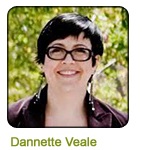 Last week, I spoke with Dannette Veale of Cisco regarding how Cisco is leverainge virtual and new technologies for their events and conferences. This week, Dannette shares her predictions for 2011.
Last week, I spoke with Dannette Veale of Cisco regarding how Cisco is leverainge virtual and new technologies for their events and conferences. This week, Dannette shares her predictions for 2011.
It’s the time of year for 2011 predictions. What do you see in store for the industry in 2011 and which technology(ies) do you think will gain popularity?
I see mobility as being the big one and will start looking at that. We leveraged Ustream last year and have a lot of interest with the mobile app for Ustream iPhone. I also think that with the onset of tablets and number of tablets being put out by Samsung and Apple, we will see a huge amount of event tools and experience extended out to mobile, especially tablets. We will see people go beyond the provider mobile applications and opt for white label applications for mobile to create a push-pull opportunity.
For example, download a hypothetical Cisco Live mobile app that will notify the user of updates to content, new contests and upcoming live events they can watch via their mobile device. This type of mobile application could be leveraged as an audience acquisition tool. If I’m not reaching you via the event web site, direct email or social media, but you’ve downloaded my app, then those individuals will be notified of updates. They are invested as they downloaded the app already. This will be a key way to distribute live video for hybrid events.
I also see mobile for event management taking off tenfold – the ability to monitor traffic to various areas with physical security reading back to data analytic tool, 40% of audience in auditorium or 60% in tradeshow floor, is a powerful tool for an event operations team. From an event management perspective, you’ll have real-time results for key surveys on key session and prize notifications on basic level, etc.
I see mobile becoming an intrinsic tool that event managemers will really be able to leverage to manage the event and do that analysis. It simply makes them more nimble.
The unconference will be realized as well, and mobile can help with this. You can watch the video, translate and ease the conference experience with maps on their device. Add to this a way to heat map where the traffic levels are, extending this function to your buddies and contacts, you can enhance the virtual experience or promote friending at a physical event itself. You’re able to see when people are online or physically at a specific location. In a large conference where there are many people, you can only send a small group of people to the event and the social gatherings are around their co-workers for dinner and other activities. The social mobile tools now give them the access to make and find connections.
The event experience will increase as a whole.
Dannette Veale’s Bio
As the virtual and social technology strategist for Cisco’s Global Sales Experience (GSX), Dannette Veale lives and breathes new media. Prior to her role on the GSX team Dannette lead the creation and drove the strategy for the award winning Cisco Live and Networkers virtual program. Dannette has also managed global online and virtual programs for a variety of Cisco groups; most notably emerging markets. When she’s not evangelizing the use of virtual environments to extend the reach of an event and broaden the overall audience demographic participating, you’ll find Dannette engaged in such varied hobbies as producing streaming media, designing Web sites, or watching classic films such as Blade Runner. Outside of her daily immersion in the bleeding edge of collaborative media, Dannette’s also been known to partake in such real world activities as gardening, baking, and knitting;while watching cyberpunk anime, of course.
Focus Expert Roundtable December 15: Virtual Events
I will be moderating a Focus.com teleconference on Virtual Events on today, December 15th at 11AM PT/ 2PM ET with Jeff Hurt, Donna Sanford, and Shannon Ryan, where we will discuss best practices for hybrid events.
Topics include:
1) Tips for engaging both physical and virtual audiences
2) Key considerations to keep top of mind
3) Technologies that can enhance the hybrid event experience
Panelists:
Shannon Ryan, Interactive Summit Lead, Focus
Donna Sanford, President , Sanford Project Partners,
Jeff Hurt, Director of Education & Engagement, Velvet Chansaw Consultin
To Participate:
Toll Free United States (866) 951-1151
Toll United States (201) 590-2255
Conference #: 4999006
Submit Questions to:
On Focus.com, use the keyword: FocusRTVE
On Twitter, use hashtag #FocusRTVE
Share this with your Friends:
Help Amy and Andrew Win a Nissan Leaf
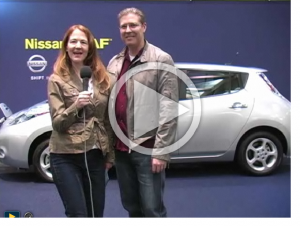 My husband and I are huge electric car enthusiasts, but not as much as our friends Amy and Andrew. I was curious when they asked me to vote for their video for a chance to win a Nissan Leaf (click on the image to the left to launch their video). I personally think their video is great =) and a great way for Nissan to drive interest in their first generation Leaf.
My husband and I are huge electric car enthusiasts, but not as much as our friends Amy and Andrew. I was curious when they asked me to vote for their video for a chance to win a Nissan Leaf (click on the image to the left to launch their video). I personally think their video is great =) and a great way for Nissan to drive interest in their first generation Leaf.
The contest rules are pretty straightforward: Schedule a time to test drive the Lead, record a video and promote it to friends and family for votes. A winner is selected from the various regions, with one winning the grand prize – a quiet car that will sneak upon you with no warning.
While this is a great way to drive people to the event, grow its list of prospective buyers, increase engagement, and spread the word, here are my recommendations to make this an event better contest.
1) You can share the video via Twitter, Facebook and email, but there was no way to embed the video to blogs and websites. Hence, why I did a screen capture and link to the video.
2) While the link takes you to a single videos, there is no video gallery to view entries from a single event. By having a centralized gallery, Nissan could leverage it’s marketing weight to segment email lists and encourage people to vote for the best video. This could also drive interest in the contest itself. Instead, the contest depends on individuals to spread the word.
3) I’m actually on the Nissan Leaf mailing list and received emails about the Nissan Test Drive tour. But I had not heard about this contest until the email from my friends, who had scheduled a test drive. My assumption is that the contest wasn’t well integrated with the other marketing channels for the Leaf – email marketing, PR (first person who received a Leaf in the Bay Area made the local news), etc. Bringing these channels together could provide Nissan with great word-of-mouth, especially as this first generation of electric cars roll out.
What do you think? And don’t forget, Vote for Amy and Andrew now! I want to be the first to ride in the car!
About
Favorite Service
Recent Comments
- on Going Virtual Isn’t Necessarily the Answer to Replacing Your Physical Events
- on Going Virtual Isn’t Necessarily the Answer to Replacing Your Physical Events
- on Going Virtual Isn’t Necessarily the Answer to Replacing Your Physical Events
- on Going Virtual Isn’t Necessarily the Answer to Replacing Your Physical Events
- on Going Virtual Isn’t Necessarily the Answer to Replacing Your Physical Events
Ads by Google
Favorite Books
Marketing Blogs
PR Blogs
- KD Paine's Measurement Blog
- Micro Persuasion
Virtual Events & Meetings Blogs
- Cisco Virtual Environments
- It's All Virtual
- The Webinar Blog
- Virtual Edge Institute

 Follow
Follow Cece Salomon-Lee is director of product marketing for Lanyon Solutions, Inc. and author of PR Meets Marketing, which explores the intersection of public relations, marketing, and social media.
Cece Salomon-Lee is director of product marketing for Lanyon Solutions, Inc. and author of PR Meets Marketing, which explores the intersection of public relations, marketing, and social media. 